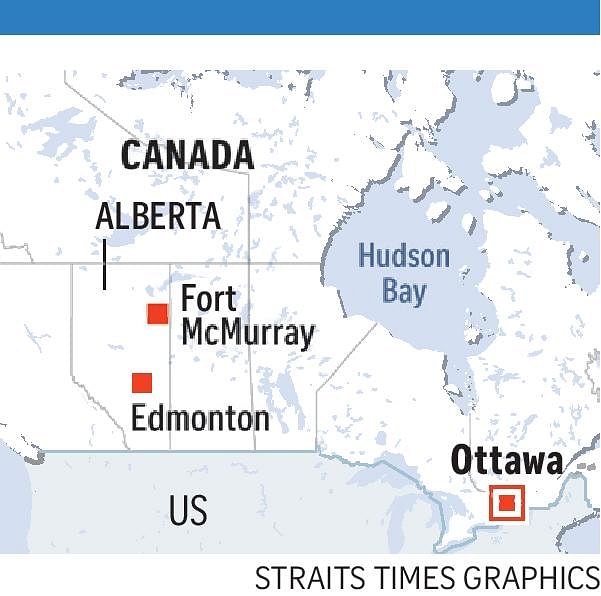SPECIAL REPORT
Remains of the blaze
Once energised by its oil-sand industry, Fort McMurray faces an uncertain future after wildfires












LAC LA BICHE (Alberta) • Fort McMurray, or Fort Make Money as some Canadians nicknamed it during its recent boom years, was the kind of place where second chances and fat pay cheques beckoned.
Those who settled there were engineers, refugees from war-torn countries and strivers from across Canada and beyond, drawn to a dot on the map in northern Alberta, a city carved out of boreal forest in a region gushing with oil riches.
Even after the price of crude began to collapse in late 2014, erasing thousands of jobs, many residents hung on, tightening their belts while waiting for the good times to return. Then, early last week, smoke and ash filled the sky, the first harbingers of a catastrophic wildfire sweeping towards the city.
The entire population of about 88,000 was forced to evacuate, most in a frantic rush. Since then, the blaze has consumed whole swathes of Fort McMurray, ranking it as one of the most devastating fires in Canada's history with an insurance claims bill that could top C$9 billion (S$9.5 billion).
The fast-moving flames turned many homes into little more than charcoal. Entire neighbourhoods were levelled, leaving behind charred chimneys looming over the ashes of what were once living rooms. In what many saw as miraculous, no one is known to have died as a direct result of the wildfires, although two people were killed in a car crash during the evacuation.
A week after the main blaze started, firefighters were looking to the weather for help yesterday as cooling temperatures and rain slowed the spread of the fires, which have cut Canada's vast oil sands production by half.

Alberta Premier Rachel Notley and other officials said the fires raging for days around Fort McMurray were moving "much, much more slowly" thanks to some rain, and temperatures were down to around 18 deg C. There were still 34 wildfires on Sunday, with five out of control, and more than 500 firefighters, backed by 15 helicopters and 14 air tankers, were battling the blaze in and around the city.
Officials, who said it was still too early to put a time line on getting people back home to Fort McMurray safely, had worried the fire could spread east to Saskatchewan province but its eastern edge was 40km from the border on Sunday. Battling a blaze they grimly refer to as "the beast", firefighters acknowledged they will probably have to wait for it to burn itself out.
Estimates of the area destroyed so far were lowered from 2,000 sq km to about 1,600 sq km.
Now, even as the displaced residents file insurance claims and pick through piles of donated clothing, many are adamant about rebuilding the city that gave them a financial lifeline as rare as the source of its prosperity, the largest oil-sand reserve in the world.
Fort McMurray "is the only place you can go, sink 10 years of your life and bank enough money to retire", Mr Kevin Lewis, 55, the owner of a transportation company, said.
He fled to an evacuation centre in Lac La Biche, 200km south, in his pick-up with only his wallet and the clothes on his back.
"Doctors and lawyers don't make the money we make," said Mr Chad Abbott, 50, a scaffolding company supervisor. He moved to Fort McMurray in 1998 with his family and worked at an oil-sand plant site, earning about C$250,000 a year.
Mr Abbott was part of a tight-knit community composed largely of oil service employees, trade workers and engineers, many of whom have lost all they own.
And for countless displaced residents, it is the lost things money cannot replace that will haunt them. Ms Ariana Caissie, 22, saved her two cats, but said her late father's recipe cards were lost. "They're just memories now."
Until environmentalists challenged the proposed 2,700km Keystone XL oil pipeline into the United States this decade, the city and the Alberta oil-sand reserve were little known outside of Canada and the world's oil companies.
But efforts to convert its deposits of tar-like bitumen into fuel go back decades, and Fort McMurray's fortunes have risen and fallen with them. The town's first modern boom was in the 1970s, when the government decided to place its bets on the costly-to-produce oil sands, and billions of dollars flowed into the area. That ended with a thud as oil prices sank in the 1980s, and the sands suddenly seemed like a dying curiosity.
The latest, and much bigger, boom was unleashed over the last decade or so as global demand for crude increased, driven by a rising China, and as companies employed more efficient technology to extract oil from the sands.
Residents, including local politicians, are committed to rebuilding, but questions remain about what Fort McMurray will be. The city's gas supply has been turned off, its power grid is damaged and the water is undrinkable.
"It's the human element," Mr Mark Routt, economist at KBC Advanced Technologies in Houston, told Reuters. He estimated that production will be shut for two to three weeks, minimum.
Mr Chad Morrison, senior wildfire manager for Alberta, said the threat to oil-sand mines north of the city had diminished, at least for now. He said fire lines had moved away from the work sites of Nexen, a unit of the Chinese group CNOOC, after inflicting only minor damage.
Husky Energy, controlled by Hong Kong billionaire Li Ka Shing, said it has completely shut its Sunrise facility, which has a capacity of 60,000 barrels a day.
NEW YORK TIMES, REUTERS, AGENCE FRANCE-PRESSE
Join ST's Telegram channel and get the latest breaking news delivered to you.
A version of this article appeared in the print edition of The Straits Times on May 10, 2016, with the headline Remains of the Canada blaze. Subscribe
